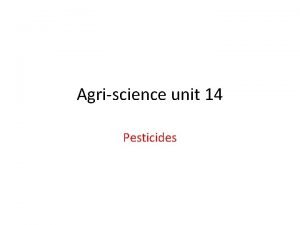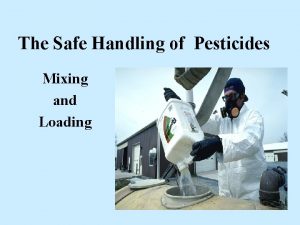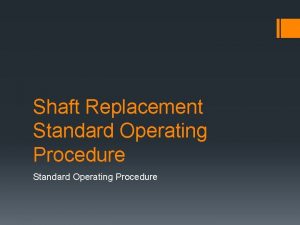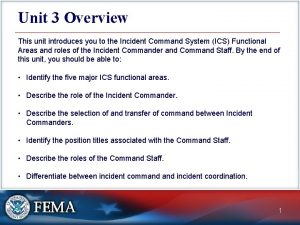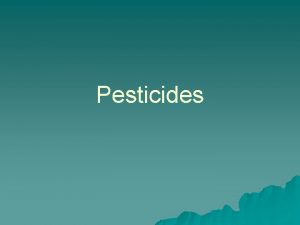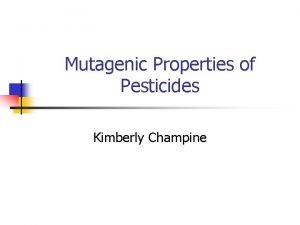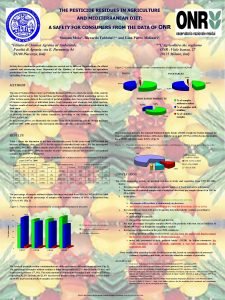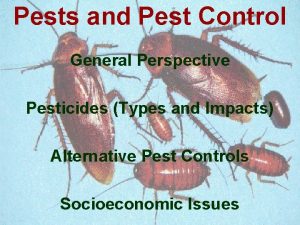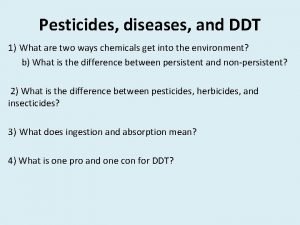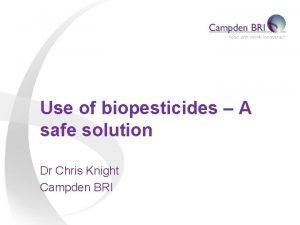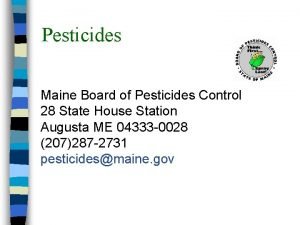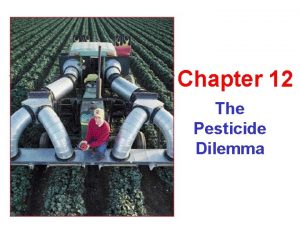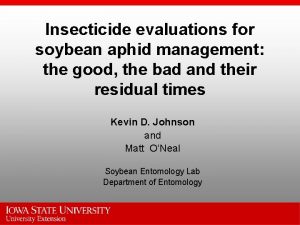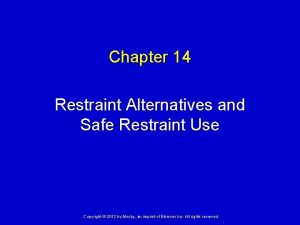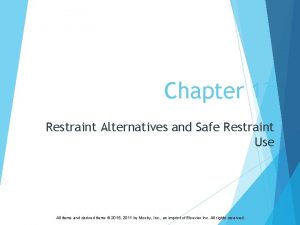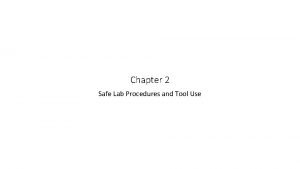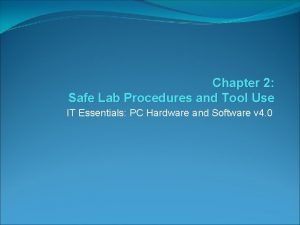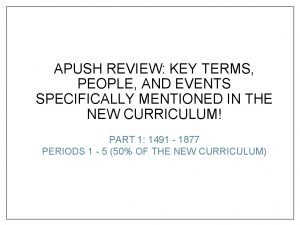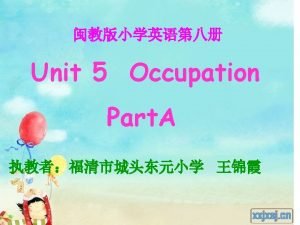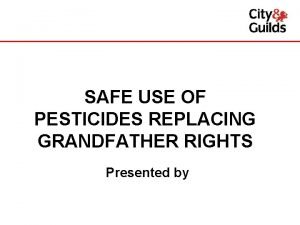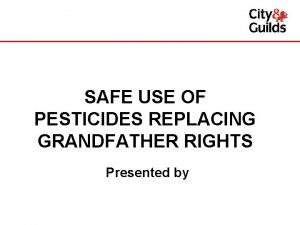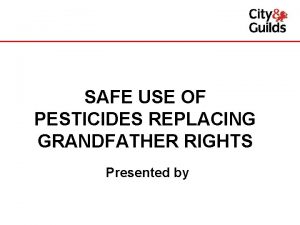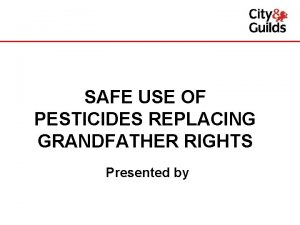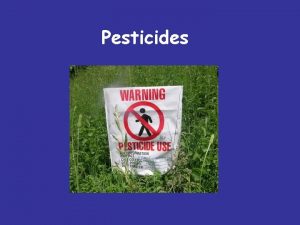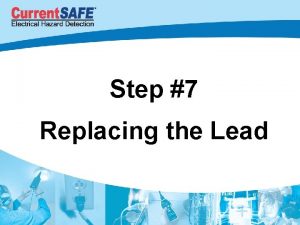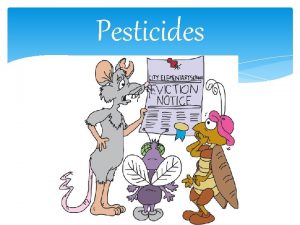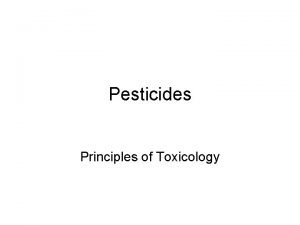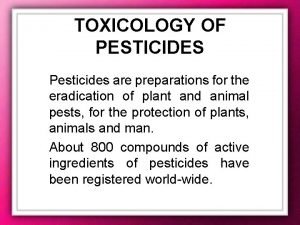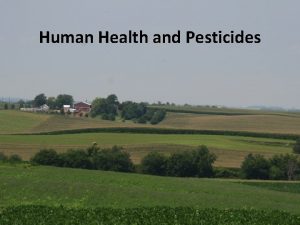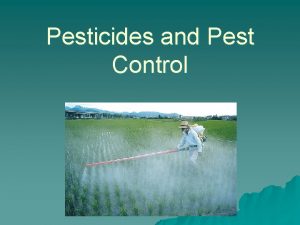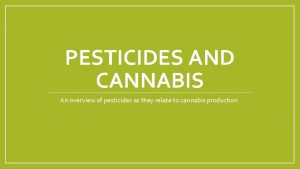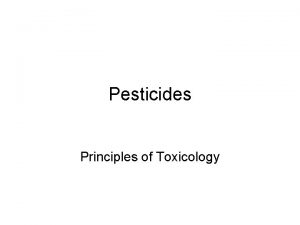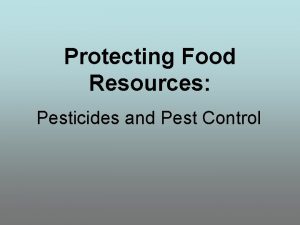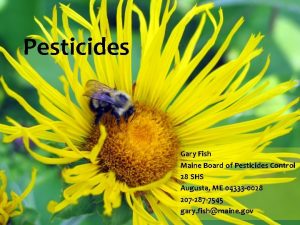SAFE USE OF PESTICIDES REPLACING GRANDFATHER RIGHTS Presented












































- Slides: 44

SAFE USE OF PESTICIDES REPLACING GRANDFATHER RIGHTS Presented by

Level 2 Award in the Safe Use of Pesticides Replacing Grandfather Rights What are Grandfather Rights? Under previous legislation, anyone born before 31 st December 1964 did not need a specified Certificate of Competence (Co. C) to apply a professional plant protection product (PPP). From 26 th November 2015, EVERYONE will require a Co. C to apply PPPs.

Introduction The qualification consists of one mandatory unit and three optional units: Mandatory: 51 The principles of safe handling and application of pesticides on own land Optional: 052: Hand held pesticide application on own land 053: Operating machines to apply pesticides on own land 054: Applying pesticides using other specific equipment or methods on own land

Unit 051 This section covers the mandatory unit: The principles of safe handling and application of pesticides on own land

Outcome 1. Know the legislative requirements and codes of practice relating to the use of pesticides on own land Assessment criterion 1. 1 Identify an operator’s responsibility under current legislation relating to the use of pesticides on own land • What is a Code of Practice? Written guidelines issued by a professional body to maintain standards. • What are ‘legislative requirements’? Laws impact on all aspects of work, including the use of pesticides. Failure to comply with these laws may result in prosecution, fines or even imprisonment. The Code of Practice for Using Plant Protection Products refers to a number of different pieces of legislation, including:

Outcome 1. Know the legislative requirements and codes of practice relating to the use of pesticides on own land Assessment criterion 1. 1 Identify an operator’s responsibility under current legislation relating to the use of pesticides on own land The Health and Safety at Work Act (1974) The Management of Health and Safety at Work Regulations (1999) Control of Substances Hazardous to Health Regulations (2002) The Control of Pesticides Regulations (1986) Personal Protective Equipment Regulations (1992) Manual Handling Operations Regulations (1992) Provision and Use of Work Equipment Regulations (1998) Wildlife and Countryside Act (1981) Food and Environmental Protection act 1985

Outcome 1. Know the legislative requirements and codes of practice relating to the use of pesticides on own land Assessment criterion 1. 1 Identify an operator’s responsibility under current legislation relating to the use of pesticides on own land You will be asked to outline ONE key point from the legislation which relates most closely to pesticide use: • Control of Substances Hazardous to Health Regulations (2002) • The Control of Pesticides Regulations (1986) • Personal Protective Equipment Regulations (1992)

Outcome 1. Know the legislative requirements and codes of practice relating to the use of pesticides on own land Write ONE key point for each in your workbook: Control of Substances Hazardous to Health Regulations (2002) - a COSHH assessment must be carried out and complied with The Control of Pesticide Regulations (1986) - only certificated operators may use professional products - users of pesticides must take all reasonable precautions to protect the health of human beings, creatures, plants, safeguard the environment and in particular avoid pollution of water Personal Protective Equipment Regulations (1992) - PPE must be supplied, and worn

Outcome 1. Know the legislative requirements and codes of practice relating to the use of pesticides on own land Assessment criterion 1. 1 Identify an operator’s responsibility under current legislation relating to the use of pesticides on own land You will be asked to outline FOUR key areas covered by The Plant Protection Products (Sustainable Use) Regulations (2012). The key points are indicated in blue on the next slides. Write FOUR of them in your workbook.

Outcome 1. Know the legislative requirements and codes of practice relating to the use of pesticides on own land Assessment criterion 1. 1 Identify an operator’s responsibility under current legislation relating to the use of pesticides on own land • Users of pesticides need to take reasonable precautions to protect human health and the environment when storing, handling, using and disposing of pesticides • keep up to date with pesticide related legislation • a person using a pesticide must receive adequate training for the task and hold a training certificate or Certificate of Competence unless working under direct supervision • use only currently authorised and legal pesticides, be aware of illegal or counterfeit products, buy only from reputable sources, check that the product delivered matches the product ordered

Outcome 1. Know the legislative requirements and codes of practice relating to the use of pesticides on own land Assessment criterion 1. 1 Identify an operator’s responsibility under current legislation relating to the use of pesticides on own land • anyone purchasing a professional product must ensure that the end user holds a Certificate of Competence for application • consider using alternative methods to pesticide application e. g. Integrated Pest Management or Integrated Weed Management • preference should be given to products not classified as dangerous for the aquatic environment nor containing priority hazardous substances when the use of the product represents a risk to water quality

Outcome 1. Know the legislative requirements and codes of practice relating to the use of pesticides on own land Assessment criterion 1. 1 Identify an operator’s responsibility under current legislation relating to the use of pesticides on own land • the amount of pesticide used and frequency is a low as reasonably practicable on: roads, railway lines, very permeable surfaces and sealed surfaces where there is a greater risk of run off or contamination of surface and groundwater; areas used by the general public or vulnerable groups; areas in the close vicinity of healthcare facilities; protected areas identified under the Water Framework Directive; and areas recently treated by pesticides which will be accessible to agricultural workers • equipment must be inspected in line with current legislative requirements • application must be confined to the intended target.

Outcome 1. Know the legislative requirements and codes of practice relating to the use of pesticides on own land • All sprayers EXCEPT handheld equipment and knapsack sprayers must be inspected • Professional users must conduct regular calibration and technical checks • The majority of active sprayers will need testing by 26 th November 2016. • Anyone leasing or owning plant protection equipment must make sure it is not used unless it has passed inspection • An annual test is requirement of the major crop assurance schemes and many supermarket protocols.

Outcome 1. Know the legislative requirements and codes of practice relating to the use of pesticides on own land Assessment criterion 1. 2 Identify an operator’s responsibility under current codes of practice relating to the use of pesticides on own land You will be asked to provide TWO responsibilities under current codes of practice:

Outcome 1. Know the legislative requirements and codes of practice relating to the use of pesticides on own land Assessment criterion 1. 2 Identify an operator’s responsibility under current codes of practice relating to the use of pesticides on own land Write TWO responsibilities in your workbook: • follow current Code of Practice for the safe use of pesticides • use pesticides in a safe manner • carry out and comply with an environmental assessment of the application site • ensure that equipment is in good condition • the application equipment has been correctly calibrated

Outcome 2. Understand the relevance of pesticide product information Assessment criterion 2. 1 Explain the relevance of product label information All pesticide products have essential information printed on the product label. It is vitally important to read this information before using a pesticide. You will be asked to give FOUR reasons for the relevance of product label information:

Outcome 2. Understand the relevance of pesticide product information Assessment criterion 2. 1 Explain the relevance of product label information Write FOUR of these reasons in your workbook: • • • important information – must be strictly complied with hazards associated with the product enviromental precautions PPE requirements active substance(s)/ingredients – in the event of an emergency approved field of use – industry sector maximum dose rate – must not be exceeded timing of application(s) – manufacturer’s recommendations current authorisation number – evidence of authorisation approved adjuvants – only approved adjuvants can be used

Outcome 3. Understand how to minimise the risk of human contamination and implement emergency procedures Assessment criterion 3. 1 Identify possible routes of pesticide contamination You will be asked to identify THREE possible routes of contamination:

Outcome 3. Understand how to minimise the risk of human contamination and implement emergency procedures Assessment criterion 3. 1 Identify possible routes of pesticide contamination Write THREE possible contamination routes in your workbook: • through the eye • absorption through the skin • inhalation • ingestion • injection

Outcome 3. Understand how to minimise the risk of human contamination and implement emergency procedures Assessment criterion 3. 2 Identify appropriate Personal Protective Equipment (PPE) for pesticide application CE marking European law requires that PPE has to comply with legislation. The CE marking is a mandatory conformity mark; it shows that PPE with this mark conforms to the essential requirements of the applicable EC directives. Only PPE that conforms and is specified on the product label should be supplied and worn You will be asked to state the importance of quality standard marks, and to identify the items of PPE required for ONE specific pesticide operation – giving the type, condition and features:

Outcome 3. Understand how to minimise the risk of human contamination and implement emergency procedures Assessment criterion 3. 2 Identify appropriate Personal Protective Equipment (PPE) for pesticide application State in your workbook: The CE mark on PPE shows that it conforms with EC directives Think of a pesticide operation you know well – then complete the table in your workbook.

Outcome 3. Understand how to minimise the risk of human contamination and implement emergency procedures Assessment criterion 3. 3 Identify the symptoms of pesticide contamination You will be asked to state TWO symptoms of pesticide contamination:

Outcome 3. Understand how to minimise the risk of human contamination and implement emergency procedures Assessment criterion 3. 3 Identify the symptoms of pesticide contamination Write TWO symptoms in your workbook: These may include: • headache • nausea • stomach pains • rashes /blistering of skin

Outcome 3. Understand how to minimise the risk of human contamination and implement emergency procedures Assessment criterion 3. 4 Explain appropriate procedures for dealing with pesticide contamination You will be asked to explain how to deal with contamination of yourself and a third party:

Outcome 3. Understand how to minimise the risk of human contamination and implement emergency procedures Assessment criterion 3. 4 Explain appropriate procedures for dealing with pesticide contamination Write your answers in your workbook: Contamination of self – rapidly identify contamination, and decontaminate, remove contaminated PPE and clothing, seek medical advice Contamination of third parties – protect yourself, relocate to safe area, decontaminate if possible, remove contaminated PPE and clothing and contact emergency services Both – a product label and the Material Safety Data sheet (MSDS) must be made available to the emergency services

Outcome 4. Know how to store and transport pesticides safely Assessment criterion 4. 1 State how pesticides should be stored You will be asked to state THREE ways in which pesticides should be stored:

Outcome 4. Know how to store and transport pesticides safely Assessment criterion 4. 1 State how pesticides should be stored Write three of these points in your workbook: • in original container, with product labels • maintain stock security to avoid theft and misuse careful handling to reduce chances of spillage • adequate containment facilities • product segregation to avoid dangerous occurrences (explosion, fire, vapour)

Outcome 4. Know how to store and transport pesticides safely Assessment criterion 4. 2 State how pesticides should be transported You will be asked to state two ways in which pesticides should be transported:

Outcome 4. Know how to store and transport pesticides safely Assessment criterion 4. 2 State how pesticides should be transported Write TWO of these points in your workbook: • mobile storage is secure and meets current Codes of Practice • careful handling to reduce chances of spillage • adequate containment facilities • return unused concentrated pesticide to the store • maintain stock security to avoid theft and mis-use

Outcome 5. Know how to manage and dispose of surplus pesticide and waste materials Assessment criterion 5. 1 Identify appropriate methods of reducing waste from pesticide application You will be asked to identify ONE way to reduce waste from pesticide application:

Outcome 5. Know how to manage and dispose of surplus pesticide and waste materials Assessment criterion 5. 1 Identify appropriate methods of reducing waste from pesticide application Write ONE method to reduce waste in your workbook: • accurate calibration calculations • correct mixing of pesticides • correct calibration of sprayer/applicator

Outcome 5. Know how to manage and dispose of surplus pesticide and waste materials Assessment criterion 5. 2 State how to manage and dispose of surplus concentrate and dilute pesticides You will be asked to state TWO ways in which to manage and dispose of surplus concentrate and dilute pesticides:

Outcome 5. Know how to manage and dispose of surplus pesticide and waste materials Assessment criterion 5. 2 State how to manage and dispose of surplus concentrate and dilute pesticides Write TWO methods in your workbook: concentrated pesticide: • collected by a licensed waste disposal contractor • return to supplier if currently approved dilute pesticide: • back on to the site/target, as long as it is below the maximum dose rate • treated by a specialist treatment facility on site (e. g. a lined bio bed)

Outcome 5. Know how to manage and dispose of surplus pesticide and waste materials Assessment criterion 5. 3 State how to manage and dispose of waste materials arising from pesticide operations You will be asked to state THREE ways in which to manage and dispose of waste materials arising from pesticide operations:

Outcome 5. Know how to manage and dispose of surplus pesticide and waste materials Assessment criterion 5. 3 State how to manage and dispose of waste materials arising from pesticide operations Write THREE methods in your workbook: • dealing appropriately with empty packaging and containers - licensed waste disposal contractor • triple rinse manually • container disposal - licensed waste disposal contractor • secure storage until disposal • return to the supplier • collected by a licensed waste disposal contractor for disposal if out of approval or suspect in any other way (e. g. counterfeit)

Outcome 6. Know the record keeping requirements associated with pesticide operations Assessment criterion 6. 1 Identify the records required to comply with legislation and best practice in respect of pesticide operations You will be asked to identify TWO records required to comply with current legislation and best practice:

Outcome 6. Know the record keeping requirements associated with pesticide operations Assessment criterion 6. 1 Identify the records required to comply with legislation and best practice in respect of pesticide operations Write TWO records in your workbook: • • training records environmental assessment records COSHH assessment records control measure records duplicate stock records (storage records) pesticide treatment records waste transfer notes

Outcome 7. Understand how to minimise the risk of environmental contamination and implement emergency procedures Assessment criterion 7. 1 Identify the risks to the environment from pesticides You will be asked to identify TWO risks to the environment from pesticides:

Outcome 7. Understand how to minimise the risk of environmental contamination and implement emergency procedures Assessment criterion 7. 1 Identify the risks to the environment from pesticides Write TWO risks in your workbook: • pollution of water and the aquatic environment • pollution of specially designated areas • pollution or destruction of wildlife habitats • off target application/ contamination

Outcome 7. Understand how to minimise the risk of environmental contamination and implement emergency procedures Assessment criterion 7. 2 Describe how to carry out pesticide application to minimise the risk to the environment You will be asked to describe THREE ways in which to carry out pesticide application to minimise the risk to the environment:

Outcome 7. Understand how to minimise the risk of environmental contamination and implement emergency procedures Assessment criterion 7. 2 Describe how to carry out pesticide application to minimise the risk to the environment Describe THREE methods in your workbook: • reasonable precautions must be taken to protect the environment • application must be confined to the intended target • application carried out at an appropriate time of day • protection of human health and the environment • apply only in suitable weather conditions • Informing neighbours/other interested parties • protection of the public accessing rights of way

Outcome 7. Understand how to minimise the risk of environmental contamination and implement emergency procedures Assessment criterion 7. 3 Explain appropriate procedures for dealing with environmental contamination from pesticides You will be asked to describe how to deal with ONE spillage and a suspected case of animal poisoning:

Outcome 7. Understand how to minimise the risk of environmental contamination and implement emergency procedures Assessment criterion 7. 3 Explain appropriate procedures for dealing with environmental contamination from pesticides Describe in your workbook how to deal with a spillage and a suspected case of animal poisoning: dealing with minor spillages: – containment, collection and disposal dealing with major spillages: – contain if possible, Inform appropriate environmental agency and the emergency services dealing with suspected animal poisoning: – phone Wildlife Incident Investigation Scheme (WIIS)

Summary Level 2 Award in the Safe Use of Pesticides Replacing Grandfather Rights (PAGR) ANY QUESTIONS ON UNIT 1?
 Agriscience unit 14 completion answers
Agriscience unit 14 completion answers Safe handling of pesticides
Safe handling of pesticides Safe feed safe food
Safe feed safe food Safe people safe places
Safe people safe places Procedure in replacing shaft
Procedure in replacing shaft Establish objectives, make assignments, and order resources
Establish objectives, make assignments, and order resources The pros and cons of pesticides
The pros and cons of pesticides Pesticides classification
Pesticides classification Mediterranean diet pesticides
Mediterranean diet pesticides Different types of pesticides
Different types of pesticides Example of pesticides
Example of pesticides Biopesticides examples
Biopesticides examples Biopesticides definition
Biopesticides definition Maine board of pesticides
Maine board of pesticides Pesticide treadmill definition
Pesticide treadmill definition Soybean aphid pesticides
Soybean aphid pesticides Integrated pest management ____ than pesticides.
Integrated pest management ____ than pesticides. Cannabis pesticides
Cannabis pesticides Positive rights vs negative rights
Positive rights vs negative rights What is littoral rights
What is littoral rights Characteristics of rights
Characteristics of rights Legal rights vs moral rights
Legal rights vs moral rights Negative right
Negative right Negative rights
Negative rights Positive rights vs negative rights
Positive rights vs negative rights Negative right
Negative right Restraint alternatives are
Restraint alternatives are Restraint alternatives and safe restraint use
Restraint alternatives and safe restraint use Safe lab procedures
Safe lab procedures Safe lab procedures and tool use
Safe lab procedures and tool use The old grandfather and his little grandson theme
The old grandfather and his little grandson theme The grandfather gary soto
The grandfather gary soto Reconstruction and its aftermath
Reconstruction and its aftermath Mother
Mother Titanic poem by derek mahon
Titanic poem by derek mahon Review exercise terms and events answer key
Review exercise terms and events answer key Father grandfather
Father grandfather Who was ashoka's grandfather? *
Who was ashoka's grandfather? * Holes chapter 1-5 quiz
Holes chapter 1-5 quiz Logical paradox examples
Logical paradox examples Identify the area of segment aob to the nearest hundredth.
Identify the area of segment aob to the nearest hundredth. Structure of climbing my grandfather
Structure of climbing my grandfather Shia imams family tree
Shia imams family tree Contribution of archibald mclaren in physical education
Contribution of archibald mclaren in physical education Occupation of grandmother
Occupation of grandmother
